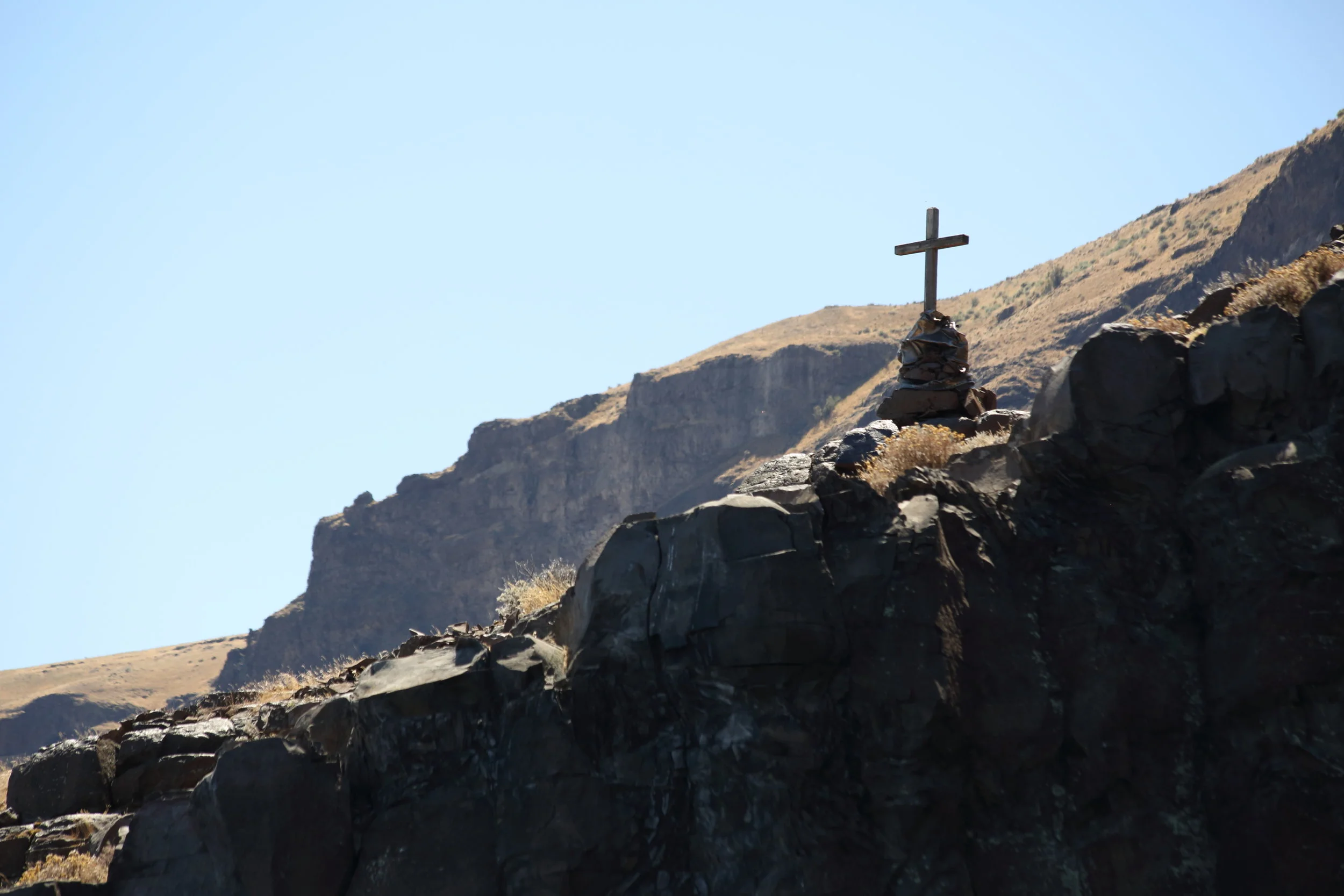the story behind the cross
47° 13 '27.3" N 120° 4' 30.0" W
A couple miles up river, a cross sits atop the lower end of a sheer cliff face along the south shore, where the river’s southerly flow has just completed a 90 degree bend to the left. These diagonally ascending cliffs of columnar basalt are a popular place for thrill seekers to jump from, at a height not greater than the limit of their courage.
Locals say the cross is near the location where a U.S. Navy jet crashed, and that it's a memorial to the two aviators who lost their lives. It's made of 4”x4” timbers, with some metal aircraft debris encircling its base. Crescent Bar Outfitters doesn’t know who erected the cross, but we’d like to.
Over the years we’ve heard a few versions of the cross’ origins, but we decided to jump in and investigate it a little further so we could share some facts with you. What follows is our recounting of public information pieced together from online searches on the subject. Information sources included newspaper articles and other web postings. Here's what we've learned...
WHAT HAPPENED
On the morning of October 10, 1991, three A-6E Intruder aircraft of VA-155 departed Whidbey Island NAS on a training mission to a bombing range in Boardman, Oregon. Like the “fly-bys” we see today at CB, the mission was to be flown along VR-1350, a visual training route that crosses the Cascade Mountains into eastern Washington, continuing southward to Oregon. This route is famous in the military as being one of the most beautiful and challenging to fly. This particular training flight was a two plane mission, followed by a third plane that was filming it.
As the planes followed the river south toward CB, the lead plane, piloted by Lt. Cmdr. Dan DeWispaleare (age 32) with navigator-bombardier Lt. (j.g.) Grady Hackwith (age 26) lost altitude and crashed into the river where it makes a ninety-degree bend, near the cliffs where the cross still sits. Both men were killed. Lt. Cmdr. DeWispaleare’s body was recovered several hours afterward, but it took more than two weeks using advanced technology submersibles to recover Lt. (j.g.) Hackwith’s body. Only about half of the aircraft was recovered.
WHY IT HAPPENED
The 50-page Navy report by Cmdr. James G. Butler cites pilot error as the cause, stating that “regardless of the glowing praise for his performance both in the air and on the ground, the mishap pilot had established a subtly aggressive tendency in the cockpit, which was overlooked by his contemporaries due to his proven record of achievement and superior tactical acumen”. It said that the pilot made an unplanned maneuver with the jet just before a planned left turn was to be made, and it plummeted from about 1,500 feet before crashing into a cliff and falling into the river. That’s the very condensed official cause.
A Seattle P-I article written by Ed Offley in May, 1992 stated: Butler concluded that DeWispelaere had performed what a Navy spokesman terms a “show-off maneuver” shortly before his plane plunged into the water. Instead of banking the A-6E 90 degrees to the left to initiate the turn, the pilot attempted to rotate his plane 270 degrees to the right. “That maneuver is not a trained maneuver. It is acquired through the guts and skills of the pilots alone,” Whidbey spokesman Lt. Joe Nededog said. “It is not authorized (by Navy training rules)”. The P-I article also said that “Butler concluded that the maneuver played a contributing role in the accident, but that the actual cause was insufficient altitude of the A-6E as it began the turn.”
ABOUT THE MEN
Since we haven’t been able to locate much information about Lt. (j.g.) Hackwith, we’ll share what we’ve learned about him first. We read a moving tribute to him written by former Navy pilot Paco Chierici, who flew with him. In short, Chierici describes Hackwith as “a brother”, who was a great man, a loyal friend, and a solid, professional aviator. Sounds like he’s someone we’d all like to have known, and someone we should all be grateful to for his service. We’d like to know more about him.
Lt. Cmdr. DeWispaleare’s accomplishments were many, and it appears he too was an outstanding aviator, with his commanding officer telling the Seattle Times that DeWispaleare “was his squadron’s best pilot”. He was a decorated veteran of the 1991 Gulf war, flying more than 40 missions from the aircraft carrier Ranger. He was a recipient of the Distinguished Flying Cross (with Combat V), the Air Medal (with Combat V) and two Navy Commendation Medals (one with Combat V).
DeWispaleare was a great pilot who probably pushed beyond his limit that day, when the mission didn't require it. And while it may be easy for some to simply say “pilot error” caused the crash, we prefer to think of it a little differently. We believe that defending America requires individuals willing to constantly push the boundaries, and we're grateful for all who do this. The ability to decisively fly and fight during wartime in an A6-E often demanded limitless courage, which both of these men likely had. Despite the unfortunate circumstances, we salute and thank them for their service, and encourage you to do the same next time you see the cross.

